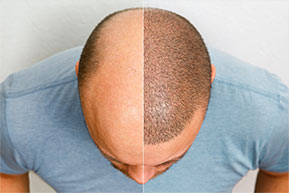Contents
Understanding the Causes and Solutions

A receding hairline is a common concern that affects a significant portion of the male population. Hair loss among men increases with ag. While 16% of men aged 18-29 experience hairloss, the rate escalates to 53% for men 40-49. [1] Understanding the causes behind a receding hairline and the available solutions can help patients in Birmingham, AL, make informed decisions about their hair restoration options.
Dr. Grady Core of Core Plastic Surgery offers men the opportunity to address their receding hairline through advanced hair restoration procedures. Dr. Core can help Birmingham men regain their confidence and achieve natural-looking results with his expertise and state-of-the-art techniques. He knows how a full head of hair can positively impact one’s self-esteem and overall well-being leading to a rich, full life in all areas. To learn more about Dr. Core’s techniques, read on, then call (205) 397-2100 to schedule a consultation.
About the Receding Hairline
A receding hairline is a specific hair loss pattern that predominantly affects men. While both men and women can experience hair loss, the pattern and progression differ significantly between the sexes. Here are a few reasons why a receding hairline is more common in men:
Androgenetic Alopecia
The most common cause of a receding hairline is male pattern baldness, known as androgenetic alopecia. This condition is genetically determined and influenced by the hormone dihydrotestosterone (DHT). [2] DHT binds to hair follicles in susceptible individuals (around half of all men), causing them to shrink over time. The frontal hairline and crown area are particularly sensitive to the effects of DHT, leading to a receding hairline in men.
Hormonal Differences
Men naturally have higher levels of androgens, including testosterone. Androgens play a role in hair growth regulation but can also contribute to hair loss when converted into DHT.
Genetic Predisposition
Scientists believe genetic factors significantly influence the likelihood of developing a receding hairline. [3] If a man has a family history of male pattern baldness, he is more likely to experience hair loss himself. Certain genes cause hair follicle sensitivity to DHT, and if they are inherited, it can contribute to developing a receding hairline.
As we mentioned, hair loss tends to increase with age in men. As men grow older, the hair growth cycle slows down, and hair follicles become more susceptible to the effects of DHT. This progressive miniaturization of hair follicles results in a receding hairline over time.
Androgen Receptor Distribution
The distribution of androgen receptors in the scalp differs between men and women. Men tend to have higher concentrations of androgen receptors in the frontal and vertex areas of the scalp, which are the regions above the forehead.
For men in Birmingham, AL, concerned about their receding hairline, Dr. Core and his team at Core Plastic Surgery offer state-of-the-art hair restoration procedures tailored to individual needs. With their expertise, patients can regain a fuller and natural-looking head of hair, boosting their self-image and transforming their lives. Don’t let a receding hairline hold you back—schedule a consultation with Dr. Core today and take the first step towards hair restoration and a more confident you!
What Can a Full Head of Hair Do For Your Confidence?
The impact of hair loss on men’s psychological well-being and self-perception was investigated through a comprehensive study. Participants were asked six questions to gauge their reactions to realizing their hair loss. The findings revealed that many men experienced adverse psychological effects: [4]
- 21% reported feelings of depression
- 61% indicated that they would be satisfied or very satisfied with their appearance if they had more hair
The study also examined the significance of hair to attractiveness and its impact on self-esteem. Nearly three-quarters of the men involved agreed that hair is an important feature of their image. Among the 729 men with hair loss, 35% agreed that men with hair are more attractive.
These findings shed light on the consequences of hair loss in men. They highlight the importance of hair to one’s self-image, attractiveness, and overall satisfaction with their appearance. Understanding these things helps Dr. Core understand which interventions and treatment options will best address the negative effects of hair loss and help his patients regain confidence and positive self-perception.
Confidence in the Bedroom: How a Hair Transplant Can Make a Difference
A receding hairline or hair loss can impact various aspects of a man’s life, including confidence in intimate settings. Many individuals experience concerns about their appearance and how it may affect their attractiveness and desirability to their partner.
Feeling self-assured about your physical appearance can translate into increased confidence and comfort during intimate moments. Hairline restoration can provide a newfound sense of attractiveness and rejuvenation, allowing you to fully embrace your sexuality and connect with your partner more confidently.
Hair restoration through the advanced techniques Dr. Core offers can create natural-looking results that seamlessly blend with your existing hair. The transplanted hair grows and behaves like your natural hair, enabling you to style it as desired and increasing your options for creating a visually appealing and attractive look. This newfound ability to style and manage your hair can contribute to feeling more desirable and empowered in the bedroom.
Treating a Receding Hairline in Birmingham
Treating a receding hairline often involves hair transplantation procedures, such as Follicular Unit Extraction (FUE), ARTAS, and NeoGraft. These techniques offer effective and minimally invasive solutions for restoring hair and achieving a more natural-looking hairline. Let’s explore each of these methods:
Follicular Unit Extraction (FUE) For the Receding Hairline
FUE is a popular hair transplantation method that involves the extraction of individual hair follicles from a donor area, typically the back or sides of the head and their transplantation into the receding hairline. The process uses specialized microsurgical tools that allow precise extraction and placement of hair follicles by Dr. Core. FUE leaves minimal scarring and enables a quicker recovery compared to traditional strip harvesting methods.
By extracting individual follicular units, FUE offers several unique advantages:
- FUE leaves tiny, dot-like scars scattered across the donor area instead of a linear scar. These scars are typically very small and often not noticeable, even with short haircuts or shaved heads.
- Since FUE does not leave a linear scar, it provides more flexibility in hairstyling. Patients can wear their hair short or in different styles without worrying about hiding a visible scar, providing them more freedom and versatility.
- The individualized extraction of follicular units in FUE results in less tissue trauma and quicker healing than traditional methods. Patients typically experience less discomfort, minimal swelling, and a faster return to regular activities.
- FUE allows for the selective harvesting of hair follicles, minimizing damage to the surrounding tissues. This preserves the donor area for potential future procedures, ensuring an ongoing source of viable hair follicles if additional treatments are desired later on.
ARTAS for the Receding Hairline
ARTAS is an advanced robotic hair transplant system that combines automated technology with the skill of a trained surgeon like Dr. Core. The ARTAS system scans the donor area of the scalp, creating a detailed 3D map of the patient’s hair follicles. This image-guided technology offers several unique advantages:
- The system enables precise identification and selection of optimal hair follicles for extraction. This ensures that only viable follicles are harvested, improving the overall success and quality of the hair restoration procedure.
- By relying on intelligent algorithms and automation, the ARTAS system provides a high level of consistency throughout the hair transplantation process. The system’s robotic arm follows the pre-determined parameters for extraction, delivering consistent, reliable results.
- The ARTAS system’s robotic arm uses precise movements and punches with minimal trauma to the scalp, reducing discomfort and promoting a faster healing process.
- The image-guided technology of the ARTAS system streamlines the hair transplantation process, making it more efficient. The system can analyze and harvest hair follicles faster than traditional manual techniques, reducing the overall procedure time.
NeoGraft Hair Transplant for Receding Hairline
NeoGraft is another automated hair transplant system that utilizes pneumatic pressure to extract individual hair follicles from the donor area. The system’s suction-based technology gently removes the follicles without the need for incisions with a scalpel. Once the hair follicles are extracted, they are transplanted into the desired areas to create a fuller and more youthful hairline.
NeoGraft offers many benefits, including
- No sutures or staples are required, resulting in a quicker and less invasive procedure with minimal scarring.
- The pneumatic pressure technology of NeoGraft allows for a faster extraction process than manual methods. This efficiency can contribute to shorter procedure times, reducing the overall duration of the hair transplant and improving patient comfort.
- The gentle suction-based extraction technique of NeoGraft helps maintain the integrity and viability of the harvested hair follicles. This results in a higher follicle survival rate during transplantation, enhancing the chances of successful hair growth in the recipient area.
- NeoGraft can be used for various hair restoration procedures, including small-scale and large-scale transplantations. The system’s flexibility allows for targeted extraction and precise placement of hair follicles, accommodating different patterns of hair loss and individual patient needs.
Taking the First Step Toward Restoring Your Receding Hairline with Dr. Core
During the consultation, Dr. Core will personally evaluate your hair loss pattern and assess the quality of your donor hair. He will consider various factors such as the extent of hair loss, the condition of your scalp, and your age. This thorough assessment by Dr. Core will help determine the most suitable hair restoration approach for your unique situation.
Approach the consultation with Dr. Core with confidence, knowing that you are in the hands of a skilled and compassionate specialist. He will provide you with a comprehensive cost breakdown during the consultation. Dr. Core understands the importance of transparency and will work with you to develop a treatment plan that aligns with your goals and budget.
To schedule your consultation in Birmingham, AL, call (205) 397-2100 today!
References
- Rhodes T, Girman CJ, Savin RC, et al. Prevalence of male pattern hair loss in 18-49 year old men. Dermatologic Surgery: Official Publication for American Society for Dermatologic Surgery [et Al]. 1998;24(12):1330-1332. https://doi.org/10.1111/j.1524-4725.1998.tb00009.x
- Ho CH, Zito PM. Androgenetic Alopecia. Nih.gov. Published May 18, 2019. https://www.ncbi.nlm.nih.gov/books/NBK430924/
- National Library of Medicine. Androgenetic alopecia: MedlinePlus Genetics. medlineplus.gov. https://medlineplus.gov/genetics/condition/androgenetic-alopecia/
- Alfonso M, Richter-Appelt H, Tosti A, Viera MS, García M. The psychosocial impact of hair loss among men: a multinational European study. Current Medical Research and Opinion. 2005;21(11):1829-1836. doi:https://doi.org/10.1185/030079905×61820



